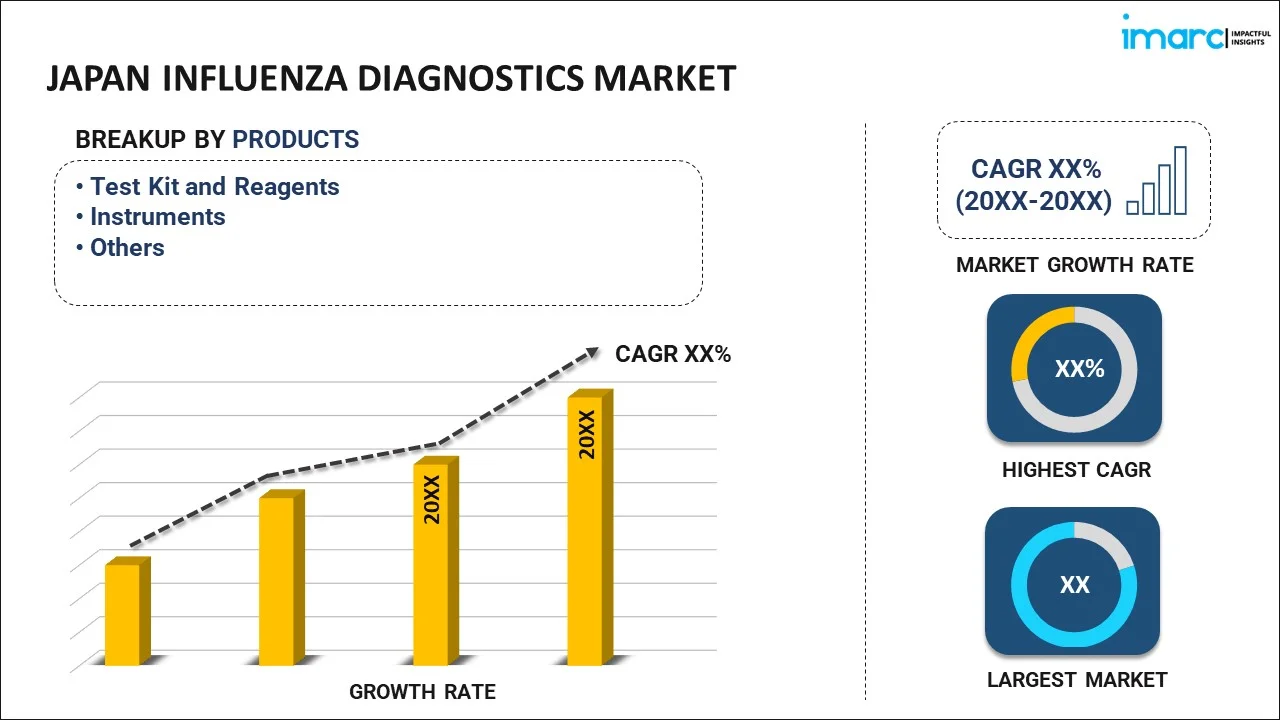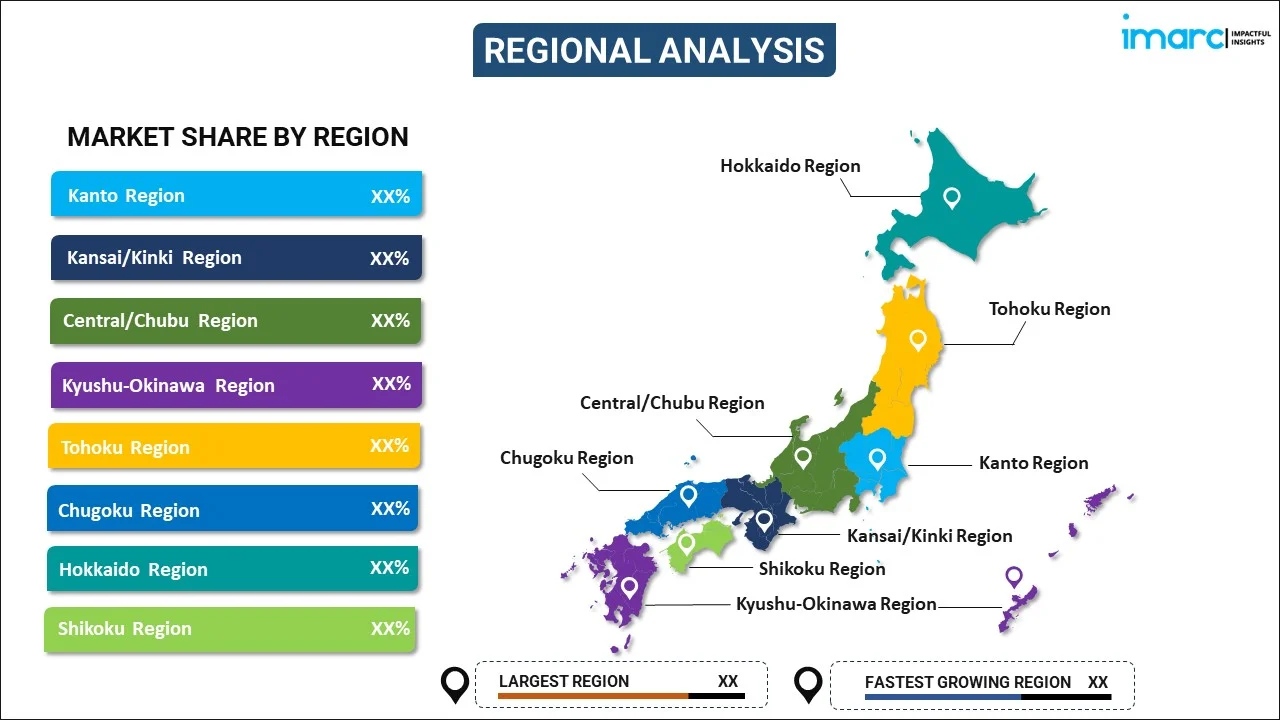
Japan Influenza Diagnostics Market Report by Product (Test Kit and Reagents, Instruments, and Others), Test Type (Molecular Diagnostic Tests, Traditional Diagnostic Tests), Type of Flu (Type A Flu, Type B Flu, Type C Flu), End User (Hospitals, Diagnostic Laboratories, and Others), and Region 2025-2033
Market Overview:
Japan influenza diagnostics market size reached USD 63.2 Million in 2024. Looking forward, IMARC Group expects the market to reach USD 105.0 Million by 2033, exhibiting a growth rate (CAGR) of 5.3% during 2025-2033. The market is being driven by several factors, including the expansion of vaccination campaigns, the convenience offered by point-of-care testing, intensified research into influenza viruses, and increased awareness through public health initiatives.
|
Report Attribute
|
Key Statistics
|
|---|---|
|
Base Year
|
2024
|
|
Forecast Years
|
2025-2033
|
|
Historical Years
|
2019-2024
|
| Market Size in 2024 | USD 63.2 Million |
| Market Forecast in 2033 | USD 105.0 Million |
| Market Growth Rate 2025-2033 | 5.3% |
Influenza, commonly referred to as the flu, is a viral infection that primarily targets the respiratory system, affecting areas such as the nose, throat, and lungs. The realm of influenza diagnostics encompasses a variety of immunoassay tests designed to detect the presence of nucleoprotein antigens from influenza A and B viruses in respiratory samples. Among the available diagnostic methods are rapid antigen testing, reverse transcription polymerase chain reaction (RT-PCR), immunofluorescence assays, serological tests, and rapid molecular assays. These diagnostic options are relied upon by healthcare professionals to promptly identify and categorize influenza strains, facilitating effective treatment decisions and enabling efficient public health management.
Japan Influenza Diagnostics Market Trends:
The influenza diagnostics market in Japan is witnessing substantial growth, driven by a combination of factors. Foremost among these is the increasing incidence of flu outbreaks, which necessitates effective diagnostic solutions. Apart from this, the growing concerns regarding the potential for pandemics have spurred investments in diagnostic capabilities, making a significant contribution to market expansion. Furthermore, continuous technological advancements in the field are enhancing the accuracy and speed of diagnostic tests, positively impacting the market's growth trajectory. Besides this, public awareness campaigns focused on the importance of timely testing have encouraged more individuals to seek diagnostic services, further catalyzing market demand. Japan's rising healthcare spending supports the adoption of advanced diagnostic methods, contributing to market growth. Additionally, elderly individuals, who are more vulnerable to severe cases of the flu, are driving increased demand for diagnostic services. The growth of urban populations in Japan has led to higher infection rates, underscoring the need for robust diagnostic solutions. Frequent travel within the country and internationally has accelerated the spread of the flu, further highlighting the importance of efficient diagnostics. These factors will collectively create numerous opportunities for the influenza diagnostics market in Japan over the forecasted period.
Japan Influenza Diagnostics Market Segmentation:
IMARC Group provides an analysis of the key trends in each segment of the market, along with forecasts at the country level for 2025-2033. Our report has categorized the market based on product, test type, type of flu, and end user.
Product Insights:

- Test Kit and Reagents
- Instruments
- Others
The report has provided a detailed breakup and analysis of the market based on the product. This includes test kit and reagents, instruments, and others.
Test Type Insights:
- Molecular Diagnostic Tests
- Polymerase Chain Reaction
- Isothermal Nucleic Acid Amplification Tests
- Others
- Traditional Diagnostic Tests
- Rapid Influenza Diagnostic Tests
- Viral Culture Tests
- Direct Fluorescent Antibody Test
- Serological Tests
A detailed breakup and analysis of the market based on the test type have also been provided in the report. This includes molecular diagnostic tests (polymerase chain reaction, isothermal nucleic acid amplification tests, and others) and traditional diagnostic tests (rapid influenza diagnostic tests, viral culture tests, direct fluorescent antibody test, and serological tests).
Type of Flu Insights:
- Type A Flu
- Type B Flu
- Type C Flu
The report has provided a detailed breakup and analysis of the market based on the type of flu. This includes type A flu, type B flu, and type C flu.
End User Insights:
- Hospitals
- Diagnostic Laboratories
- Others
A detailed breakup and analysis of the market based on the end user have also been provided in the report. This includes hospitals, diagnostic laboratories, and others.
Regional Insights:

- Kanto Region
- Kansai/Kinki Region
- Central/ Chubu Region
- Kyushu-Okinawa Region
- Tohoku Region
- Chugoku Region
- Hokkaido Region
- Shikoku Region
The report has also provided a comprehensive analysis of all the major regional markets, which include Kanto Region, Kansai/Kinki Region, Central/ Chubu Region, Kyushu-Okinawa Region, Tohoku Region, Chugoku Region, Hokkaido Region, and Shikoku Region.
Competitive Landscape:
The market research report has also provided a comprehensive analysis of the competitive landscape. Competitive analysis such as market structure, key player positioning, top winning strategies, competitive dashboard, and company evaluation quadrant has been covered in the report. Also, detailed profiles of all major companies have been provided.
Japan Influenza Diagnostics Market Report Coverage:
| Report Features | Details |
|---|---|
| Base Year of the Analysis | 2024 |
| Historical Period | 2019-2024 |
| Forecast Period | 2025-2033 |
| Units | Million USD |
| Scope of the Report | Exploration of Historical and Forecast Trends, Industry Catalysts and Challenges, Segment-Wise Historical and Predictive Market Assessment:
|
| Products Covered | Test Kit and Reagents, Instruments, Others |
| Test Types Covered |
|
| Types of Flu Covered | Type A Flu, Type B Flu, Type C Flu |
| End Users Covered | Hospitals, Diagnostic Laboratories, Others |
| Regions Covered | Kanto Region, Kansai/Kinki Region, Central/ Chubu Region, Kyushu-Okinawa Region, Tohoku Region, Chugoku Region, Hokkaido Region, Shikoku Region |
| Customization Scope | 10% Free Customization |
| Post-Sale Analyst Support | 10-12 Weeks |
| Delivery Format | PDF and Excel through Email (We can also provide the editable version of the report in PPT/Word format on special request) |
Key Questions Answered in This Report:
- How has the Japan influenza diagnostics market performed so far and how will it perform in the coming years?
- What has been the impact of COVID-19 on the Japan influenza diagnostics market?
- What is the breakup of the Japan influenza diagnostics market on the basis of product?
- What is the breakup of the Japan influenza diagnostics market on the basis of test type?
- What is the breakup of the Japan influenza diagnostics market on the basis of type of flu?
- What is the breakup of the Japan influenza diagnostics market on the basis of end user?
- What are the various stages in the value chain of the Japan influenza diagnostics market?
- What are the key driving factors and challenges in the Japan influenza diagnostics?
- What is the structure of the Japan influenza diagnostics market and who are the key players?
- What is the degree of competition in the Japan influenza diagnostics market?
Key Benefits for Stakeholders:
- IMARC’s industry report offers a comprehensive quantitative analysis of various market segments, historical and current market trends, market forecasts, and dynamics of the Japan influenza diagnostics market from 2019-2033.
- The research report provides the latest information on the market drivers, challenges, and opportunities in the Japan influenza diagnostics market.
- Porter's five forces analysis assist stakeholders in assessing the impact of new entrants, competitive rivalry, supplier power, buyer power, and the threat of substitution. It helps stakeholders to analyze the level of competition within the Japan influenza diagnostics industry and its attractiveness.
- Competitive landscape allows stakeholders to understand their competitive environment and provides an insight into the current positions of key players in the market.
Need more help?
- Speak to our experienced analysts for insights on the current market scenarios.
- Include additional segments and countries to customize the report as per your requirement.
- Gain an unparalleled competitive advantage in your domain by understanding how to utilize the report and positively impacting your operations and revenue.
- For further assistance, please connect with our analysts.
 Inquire Before Buying
Inquire Before Buying
 Speak to an Analyst
Speak to an Analyst
 Request Brochure
Request Brochure
 Request Customization
Request Customization




.webp)




.webp)












